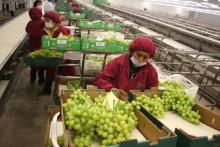
This drop is mainly attributed to the decrease in several key items, including copper minerals and their concentrates with 100%, bananas with 15.2%, and steel, copper and aluminum scrap with 8.9%.
Foreign trade has experienced a significant contraction in the value of goods exports, which registered a decrease of 73.6%, according to data from the Institute of Statistics and Census (INEC), of the Comptroller General of the Republic (CGR).
This drop is mainly attributed to the decrease in several key items, including copper minerals and their concentrates with 100%, bananas with 15.2%, and steel, copper and aluminum scrap with 8.9%.
Other products that also saw reductions include wood -9.8%, beef -8.5%, pineapple -10.4%, clothing -12.1%, hides and skins -33.3%, and other seafood -3.3%.
However, some sectors showed positive figures, among them, shrimp stood out with a notable increase of 78.3%, followed by unrefined sugar with 115.1%, fish and fish fillet with 28.5%, fishmeal and fish oil with 35.5%, coffee with 4.3%, watermelon with 5.2% and melon, which surprised with a growth of 325.3%.
As for imports of goods, the value also reflected a decrease, registering a drop of 6.2%. This decline was driven by a reduction in intermediate goods -15.2% and capital goods -10.7%, however, a slight increase was observed in consumer goods, with an increase of 1.5%.
On the other hand, the net weight of imports of goods was reduced by 10.9%, with a notable decrease in intermediate goods by -23.4% and capital goods by -17.2%, despite this, consumer goods showed a positive variation of 1.9%.
The total weight of goods exports also showed a negative rate of 50.5%, with falls in items such as bananas -13.8%, steel, copper and aluminum waste -3.2%, watermelon -4.2%, pineapple -30.8%, beef -11.1%, coffee -9.2%, and hides and skins -31.9%.
On the other hand, some activities showed positive growth, such as wood 5.7%, unrefined sugar 82.6%, fishmeal and fish oil 46.2%, fish and fish fillet 8.5%, shrimp 82.9% and melon 461.4%.
Finally, trade in the Colon Free Zone also registered a negative variation of 12.2%, reflecting a decrease in imports -11.9% and in re-exports -12.5%, however, the weight of trade in this zone showed an increase of 7.7%.










